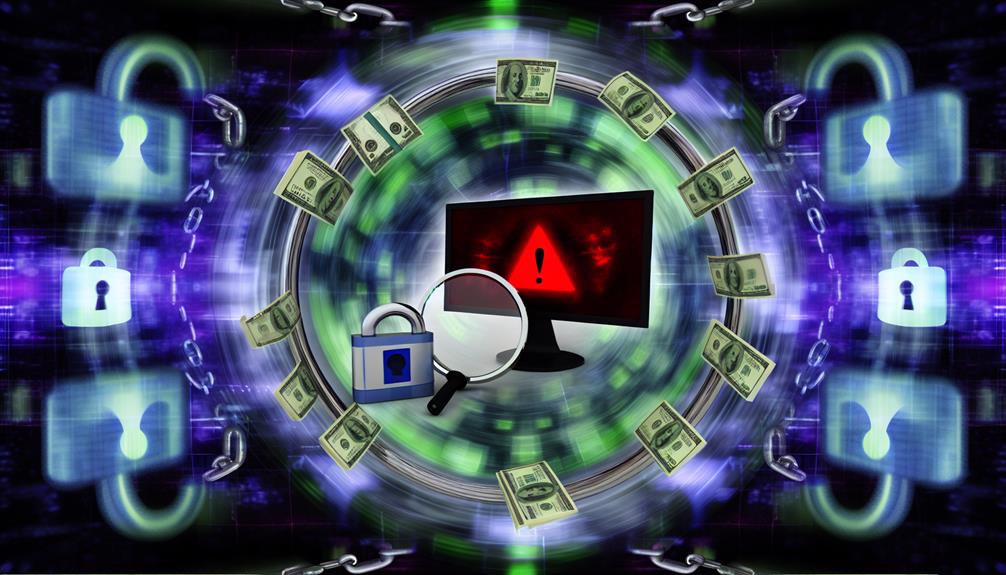When you're dealing with authentication issues in untrusted domains, it can feel like you're maneuvering through a minefield, especially if you're on a tight budget. You might think that robust security measures are out of reach, but there are practical strategies you can implement without overspending. From strong password policies to staff training on phishing awareness, there are ways to tighten your defenses. Curious about how to maximize your resources and protect your domain effectively? Let's explore some practical tips that can safeguard your operations while keeping costs manageable.
Authentication Issues in Untrusted Domains
In untrusted domains, authentication becomes a complex issue due to misconfigured trust relationships that can hinder access to crucial resources.
You'll find that Windows Authentication plays a critical role here, but its limitations may lead to failed SSPI handshakes, resulting in significant productivity impacts.
Understanding these dynamics is essential for troubleshooting and implementing effective authentication strategies in your organization.
Defining Untrusted Domains
Untrusted domains represent a significant challenge in network authentication, often resulting in failures when trying to access essential services. These domains lack a validated trust relationship within your network, which can hinder user access to important resources.
Issues with untrusted domains frequently stem from misconfigured Active Directory trust settings, blocking users from logging in or utilizing integrated services.
The prevalence of authentication problems related to untrusted domains is particularly notable in environments with multiple domains, where persistent authentication challenges can disrupt productivity. Common causes for these issues include incorrect user credentials, missing trust relationships, and network connectivity problems with domain controllers.
To effectively address untrusted domain issues, you'll need to conduct a thorough review of your domain configurations. Make sure that proper trust relationships are established and that accurate DNS settings are in place.
By understanding the factors contributing to untrusted domains, you can take proactive steps to mitigate authentication failures, ultimately enhancing your network's reliability and efficiency.
The Role of Windows Authentication and Limitations
Windows Authentication can create significant hurdles when you're trying to access resources across untrusted domains.
You might encounter various scenarios that lead to authentication failures due to trust issues or misconfigurations. Understanding these common situations can help you identify and address the limitations effectively.
- Missing trust relationships in Active Directory.
- Network connectivity issues affecting domain controller communication.
- Kerberos authentication protocol failures due to domain trust complications.
Common Scenarios of Untrusted Domain Access
Accessing resources across multiple domains can present significant challenges, especially when trust relationships are absent.
Untrusted domain access often leads to login failures due to misconfigured Active Directory settings or incorrect user credentials.
Network issues, like firewall restrictions, complicate authentication.
Switching to SQL Server Authentication can bypass domain trust requirements, while regular audits help prevent recurring authentication issues in these untrusted domains.
Implications of SSPI Handshake Failure
When you encounter an SSPI handshake failure in untrusted domains, it raises significant supply chain security concerns.
These failures can expose vulnerabilities that malicious actors might exploit, jeopardizing both data integrity and organizational resources.
It's essential to assess and strengthen your authentication mechanisms to maintain secure interactions across all domains.
Supply Chain Security Considerations
Supply chain security hinges on the integrity of authentication processes, particularly in untrusted domains where an SSPI handshake failure can pose significant risks.
Your security team must prioritize robust domain trust configurations and conduct regular audits to prevent unauthorized access.
Effective communication and incident response plans are essential for addressing handshake failures, ensuring operational integrity, and protecting sensitive information across interconnected systems.
Challenges of Logging In From Untrusted Domains
When you log in from an untrusted domain, you may face authentication failures that stem from various causes.
Identifying the root of these issues, like incorrect user credentials or misconfigured trust relationships, is essential for smooth access.
The error message "SSPI Handshake Failed: The Login Is From An Untrusted Domain" often highlights these challenges, impacting your productivity.
Identifying the Causes of Login Failures
When logging in from untrusted domains, supply chain risk factors can greatly impact your authentication success.
Misconfigured settings, incorrect credentials, and inadequate trust relationships often stem from vulnerabilities in third-party systems, complicating your access.
Understanding these risks is essential in diagnosing and preventing login failures in your environment.
Supply Chain Risk Factors
Authentication challenges from untrusted domains can greatly disrupt access to critical resources, especially in complex network environments.
Issues like missing trust relationships, misconfigured Active Directory settings, and network connectivity problems can lead to persistent login failures.
Implementing robust security measures and understanding the root causes of these failures is essential for troubleshooting and restoring access, ensuring seamless operation within your infrastructure.
'SSPI Handshake Failed: The Login Is From An Untrusted Domain'
Encountering the "SSPI Handshake Failed: The Login Is From An Untrusted Domain" error can be frustrating, especially for users trying to access vital services.
This error usually indicates problems with domain trust relationships, preventing effective access to integrated services. Security risks arise when these trust relationships are missing or misconfigured, leading to persistent authentication failures that hinder user productivity.
Common causes include incorrect user credentials, network connectivity issues with domain controllers, or a lack of proper configuration between domains.
To resolve these trust issues, you need to verify that all involved machines belong to the same domain and that the trust configuration is correctly established.
If establishing domain trust proves challenging, utilizing SQL Server Authentication as an alternative access method can help. This allows you to bypass these issues by logging in with a username and password, thereby mitigating security risks associated with misconfigured domain environments.
Access Through Untrusted Domains
Accessing SQL Server from untrusted domains presents unique challenges that often stem from misconceptions about Windows Authentication.
You might encounter persistent authentication issues due to misconfigured settings or lack of proper trust relationships.
Understanding these nuances, along with examining case studies like SCCM in untrusted environments, can help you navigate these complexities effectively.
SQL Server Untrusted Domain Access Issues
When accessing SQL Server from an untrusted domain, best practices for secure access become critical.
You'll want to guarantee your connection string is accurate and consider using SQL Server Authentication to bypass domain trust issues.
Additionally, maintaining stable network connectivity to domain controllers and regularly auditing trust relationships can greatly reduce access challenges.
Best Practices for Secure Access
Steering access to SQL Server from untrusted domains presents unique challenges that require strategic solutions.
To protect sensitive information, follow these best practices:
- Use SQL Server Authentication to bypass domain trust issues.
- Confirm both machines are in the same domain with established trust.
- Regularly verify connection strings for accuracy to avoid access errors.
Common Misconceptions About SQL Untrusted Domain Windows Authentication
Misunderstandings about SQL Server Windows Authentication across untrusted domains can lead to frustrating authentication failures for users. Many believe this authentication method will work seamlessly, but the lack of a trust relationship between domains often results in access issues.
You need to review your Active Directory configurations and user credentials to address these persistent problems.
Another common misconception is overlooking network connectivity to domain controllers. If your connection is unstable, it can further complicate authentication processes when accessing SQL Server from an untrusted domain.
Regularly checking connectivity can save you considerable headaches.
If you encounter consistent issues, consider switching to SQL Server Authentication. This alternative allows you to use a specific username and password, bypassing the complexities of Windows Authentication in untrusted domains.
It's also essential to remember that misconfigurations in domain settings or Active Directory can lead to untrusted domain errors.
Regular audits of your domain trust relationships and security protocols can help mitigate these risks.
Case Studies: SCCM Untrusted Domain
Accessing System Center Configuration Manager (SCCM) from untrusted domains often reveals significant authentication challenges. Your team may encounter persistent login failures stemming from misconfigured trust relationships between domains.
When Active Directory permissions don't recognize external domain credentials, access is denied, complicating management tasks.
To troubleshoot these issues, you need to verify domain trust configurations. Confirm that proper DNS settings are in place to facilitate communication between domains. Your team should also regularly review and update these trust relationships to mitigate access failures. This proactive approach enhances security and prevents unauthorized domain access.
In situations where domain trust fails, consider implementing SQL Server Authentication as a temporary fallback method. This can provide crucial access to SCCM while you resolve underlying trust issues.
However, remember that this is a short-term solution; focusing on fixing the root cause is critical for long-term stability.
Solutions and Best Practices
To effectively mitigate risks associated with untrusted domains, you need to implement practical authentication strategies tailored to your budget.
Focus on secure methods like multi-factor authentication and regular monitoring of domain configurations.
Additionally, understanding the limitations of untrusted domains in relation to Windows authentication can guide you in making informed security decisions.
Mitigating Risks Associated with Untrusted Domains
To effectively mitigate risks from untrusted domains, you need to adopt robust authentication measures.
Implementing strong password policies and two-factor authentication can shield your systems from unauthorized access.
Additionally, staying informed about future trends in authentication technologies will help you enhance your security framework.
Future Trends in Authentication Technologies
As authentication technologies evolve, organizations are increasingly turning to innovative solutions to address the challenges posed by untrusted domains.
Expect the rise of advanced biometric methods and decentralized identity solutions, enhancing security and user control.
Multi-factor authentication will shift towards passwordless options, while machine learning enables real-time threat detection.
Adaptive authentication strategies will assess behavior, ensuring robust protection against evolving cyber threats.
Practical Tips for Secure Authentication
When it comes to secure authentication, leveraging the right resources can make a significant difference.
You need practical tools and guidelines that enhance your security posture and streamline your processes. Here are some key resources to take into account:
- Password managers for generating and storing strong passwords.
- Training programs focused on phishing awareness for your team.
- Monitoring tools for real-time analysis of authentication logs.
Resource Recommendations for IT Professionals
Securing your organization's email communications requires a proactive approach to authentication practices.
Implement SPF, DKIM, and DMARC to combat domain spoofing and phishing. Regularly update DNS records and analyze DMARC reports for accurate security data.
Educate your staff on authentication risks and consider utilizing authentication tools for streamlined processes.
Conduct routine security audits to identify vulnerabilities and reinforce domain trust relationships effectively.
Discussion on Untrusted Domain and Cannot Be Used with Windows Authentication
Untrusted domain issues can create substantial hurdles for organizations relying on Windows Authentication, leading to frustrating access failures. These problems typically arise from misconfigured domain trust relationships within Active Directory. To resolve these issues, you must first verify that all involved machines belong to the same domain and that proper trust relationships are established.
If Windows Authentication continues to fail due to an untrusted domain, consider switching to SQL Server Authentication temporarily. This allows users to access services using a username and password, bypassing domain trust failures.
To prevent future authentication issues, regularly audit and update your trust relationships. Confirm that your DNS configurations are correct and functioning, as these play a vital role in domain communication.
Additionally, implementing user training on login procedures can greatly enhance security. Establish clear protocols for account recovery, which can mitigate risks associated with untrusted domains.




